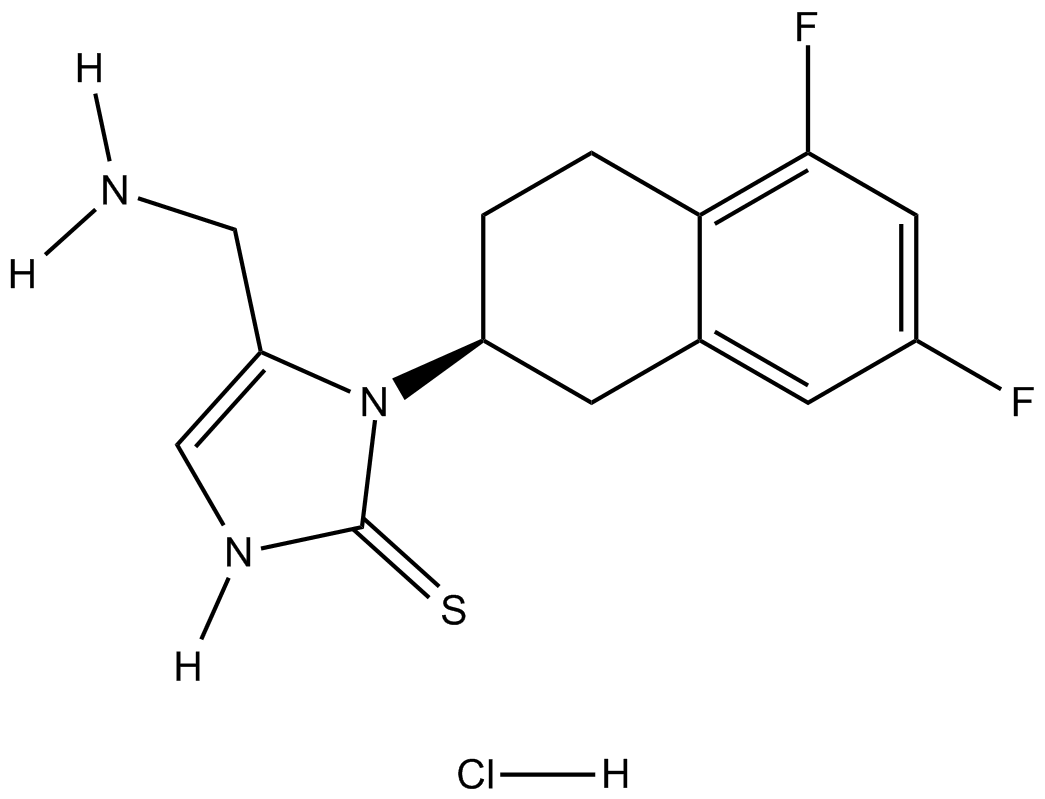Nepicastat (SYN-117) HCl (Synonyms: RS 25560-197) |
| Catalog No.GC12596 |
An inhibitor of dopamine β-hydroxylase
Products are for research use only. Not for human use. We do not sell to patients.

Cas No.: 170151-24-3
Sample solution is provided at 25 µL, 10mM.
Nepicastat (SYN-117) HCl is a potent and selective inhibitor of dopamine-β-hydroxylase with IC50 values of 8.5 and 9.0 nM in bovine and human, respectively [1].
Dopamine-β-hydroxylase is an enzyme involved in the synthesis of small-molecule membrane-bound neurotransmitters. Dopamine-β-hydroxylase catalyses the synthesis of noradrenaline [1].
Nepicastat (SYN-117) HCl is a potent and selective dopamine-β-hydroxylase inhibitor. (R)-Nepicastat exhibited 2-3 fold less potent than nepicastat [1].
In beagle dogs and spontaneously hypertensive rats, nepicastat reduced noradrenaline in a dose-dependent way and increased dopamine and dopamine/noradrenaline ratio in cerebral cortex, left ventricle and the artery. In beagle dogs, nepicastat (2 mg/kg) significantly reduced noradrenaline by 52% and increased dopamine by 646% and dopamine/noradrenaline ratio in plasma [1]. In pithed spontaneously hypertensive rats, nepicastat inhibited the pressor and positive chronotropic due to preganglionic sympathetic nerve stimulation. In spontaneously hypertensive rats, nepicastat (3 mg/kg) exhibited antihypertensive effects and reduced renal vascular resistance by 38% [2]. In rats, nepicastat significantly increased extracellular dopamine accumulation induced by cocaine and amphetamine in the medial prefrontal cortex [3].
References:
[1]. Stanley WC, Li B, Bonhaus DW, et al. Catecholamine modulatory effects of nepicastat (RS-25560-197), a novel, potent and selective inhibitor of dopamine-beta-hydroxylase. Br J Pharmacol, 1997, 121(8): 1803-1809.
[2]. Stanley WC, Lee K, Johnson LG, et al. Cardiovascular effects of nepicastat (RS-25560-197), a novel dopamine beta-hydroxylase inhibitor. J Cardiovasc Pharmacol, 1998, 31(6): 963-970.
[3]. Devoto P, Flore G, Saba P, et al. The dopamine beta-hydroxylase inhibitor nepicastat increases dopamine release and potentiates psychostimulant-induced dopamine release in the prefrontal cortex. Addict Biol, 2014, 19(4): 612-622.
Average Rating: 5 (Based on Reviews and 30 reference(s) in Google Scholar.)
GLPBIO products are for RESEARCH USE ONLY. Please make sure your review or question is research based.
Required fields are marked with *




















